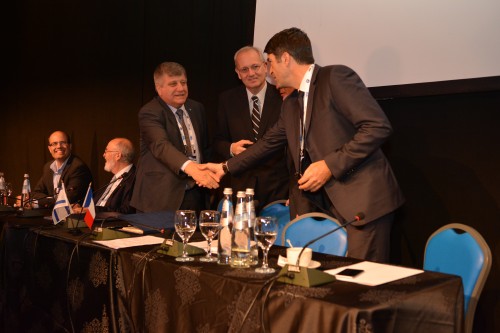The development, which was presented for the first time as part of the 66th Congress of the Astronautics Association, which is currently taking place in Jerusalem*, will combine two detectors - one developed in France and which examines the effect of temperature on the materials in the satellite's shell and a detector developed at the Nuclear Research Center in Nahal Sorek and which checks the space environment in real time

The cooperation between the Israel Space Agency at the Ministry of Science and the French space agency CNES is expanding: during the world space convention hosted by the Israel Space Agency in Jerusalem, the two agencies today announced a new joint project - "Ormad".
As part of the project, scientists from the Sorek Nuclear Research Center are developing a device that will be integrated on a French satellite. The device will provide new and significant information about the space environment, the effect of various elements in the space environment on the coating materials for satellites and the ability to withstand the extreme conditions of space. The device being developed at MG Sorek is designed to measure space radiation and the concentration of free oxygen (oxygen that does not depend on organic compounds) in space which causes the destruction of the surface of optical components, components that in order to get the best out of them must remain transparent.
The project will be financed by both agencies and is expected to be launched in the coming months. After the French satellite is launched into space in the coming years and reaches an altitude of hundreds of kilometers, it will transmit findings to Earth and the results of the measurements and the data obtained from the device will be used by the scientists of the two agencies.
Israel and France are jointly developing space environment detectors, this morning the directors of the French and Israeli space agencies signed an agreement for the joint development of detectors that will test the resistance of various materials to the space environment, and in particular materials that are supposed to protect the contents of the satellite from the space environment - especially the extreme temperature changes.
The President of the French Space Agency Jean-Yves Legal, the Ambassador of France to Israel, and from the Israeli side the Minister of Science, Technology and Space Ofir Akunis, the Chairman of the Israel Space Agency Prof. Yitzhak Ben Israel, the Director General of the Agency Menachem Gedron and the Chief Scientist at the Ministry of Economy, Dr. Avi sturdy.
The detector is based on two detectors, the Israeli ORMADD and the French TERME. Where the Israeli part consists of the initials On Orbit Material Degregation Detector while the second part, the French is derived from TERMAL, meaning temperature conditions.
Eitan Grossman from the Center for Nuclear Research in Nahal Sorek explained that the outer shell of each satellite is designed to allow a thermally controlled environment, meaning to maintain a working temperature inside the satellite. As you know, satellites are exposed to extreme temperatures - from plus one hundred degrees when exposed to the sun to minus one hundred degrees in the shadow of the earth. No electronic component can operate at these temperatures. Therefore, the satellite is wrapped in materials that will allow the devices inside it to operate, and visit colors. Mainly the materials painted white are used, the color that absorbs less radiation and emits more radiation, and therefore allows the interior of the satellite to be cooled.
"The French detector tests the effect of space on these colors, and checks whether the color fulfills its role or not. The combination of the two detectors will make it possible to monitor the change of materials according to the conditions of the space environment in real time and for long periods. This information will be used to develop more durable materials in the future. According to the agreement, the development of the joint detector is financed for two years, it has not yet been determined on which satellite it will be installed for its testing."
The project joins the "Venus" satellite project of the Israeli Space Agency and the French Space Agency - a civil satellite for environmental and research needs that will be launched in 2016 after a decade of development, most of which was done in Israel. The Venus camera is equipped with one of the most advanced cameras in the world that will take 12 pictures of the same place at the same time - each of them with a different wavelength, including in areas that are not visible to the human eye, such as infrared. The camera will pick up details that are not visible to the eye and will provide information on the condition of the soil, the quality of water reservoirs, contamination in the soil, air and sea and identification of minerals. The satellite will take at least 110 different pictures from around the world in the whole coffee and each picture will show about 700 square kilometers. The weight of the satellite is only 270 kilograms, and it is considered a lightweight satellite.
